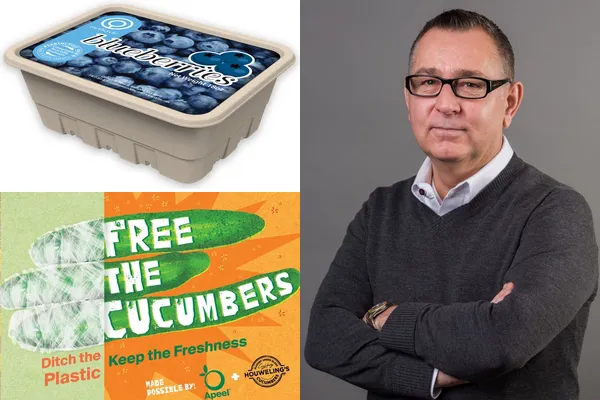Plastic has been used in produce aisles for decades – and for good reason. Not only is plastic protecting food from bacteria, temperatures and light, it allows for growers, distributors, and retailers alike to cut down on food waste; consumers to see the colorful, fresh produce they’re purchasing; growers to brand their produce and add additional attractive selling features on package; and retailers to charge per package versus per lb. or per kilo and offer the ever-important convenience items like ready-made salad bowls and pre-cut veggies.

According to National Geographic, if you shrink-wrap a cucumber in polyethylene, its shelf life improves from three days to 14. However, that same plastic will last more than a century, and will most likely make it to the oceans in contamination. Of the 78 million metric tons of plastic packaging produced globally each year, a mere 14 percent is recycled. Nine million tons of that plastic escapes collection annually.
Plastic has provided a solution for so many functions within the produce industry that it becomes nearly impossible not to rely on it. Therefore, it’s becoming increasingly important to understand how this is affecting our global environmental footprint as an industry, and shift focus to sustainable alternatives.
There have been efforts to cut plastic waste from top seal innovation, led by strong players in the industry like Oleen Smethurst, GMM for Produce at Costco Canada. I’ve seen firsthand how passionate Oleen is about reduction of waste. She has been a driving force of top seal implementation across the produce industry, aligning with the growing drive in North America towards sustainability.
Top seal packaging allows for the same quality and freshness to be delivered in packaging that reduces plastic use by 25% from that of the typical clam-shell lid. It promotes a longer shelf-life with macro-perforated film and its peelable format allows for re-seal of the packaging depending on the need. Top seal also gives suppliers an opportunity to stack more products atop one another to transport more at once, cutting down on transportation costs and environmental impact. Oleen continues to advocate for this innovation from vendors at Costco Wholesale Canada, setting an example for a whole industry on how these are current problems, with current solutions.
Every year serves as an opportunity for growth and awareness during this massive shift towards a circular economy. With hundreds of Fresh Produce players in one room, it came as no surprise to me that at this year’s PMA Fresh Summit in October, we were witnessing a packaging evolution that goes beyond using plastic at all.
Greenhouse growers Houweling’s and Apeel Sciences were showcasing a Long English Cucumber that ditches the plastic wrap, instead using a plant-based edible peel.
Apeel Sciences is an innovation company focused on reducing food and plastic waste. They have developed products for USDA Organic Certified and worked with partners ranging from small farmers and local organic growers to some of the world’s largest food brands.
They use plant-derived materials that exist in natural peels of fruit and vegetables, seeds and pulp, to create packaging solutions that are both edible and protective enough to replace the need for plastic. They aim to double or triple the shelf life of numerous types of produce, which promotes sustainable growing practices, better food quality, and less waste!
Apeel has already begun key partnerships to distribute Apeel avocados, asparagus, and limes to the European market. You will certainly be hearing more from Apeel soon!
Another alternative the industry is exploring is corrugated packaging. The advantage to corrugate boxes is that they are made from a high amount of recycled material and can be recycled again after use.
There are packaging solution companies focused on providing renewable solutions using biomaterials such as corrugate and other fiber-based packaging in global markets. Stora Enso is one example, creating an innovative box design for Primaflor’s Luchivatas Living Lettuce allowing lettuce to be packed, transported, and sold in a “micro-orchard” for the kitchen. They also created a top-opening corrugated cardboard sleeve for boxes of strawberries for Finland’s largest strawberry farm, Koivistoisen Mansikkapaikka. According to Store Enso, this design reduced labor costs by 20%, provided a longer shelf life for the strawberries, and allowed for improved branding on package.
What the leading packaging of produce looks like in the future is still not entirely clear, but the industry is certainly talking about the issue of waste more than ever before. Vanguard International is actively involved in these conversations, and will share more in 2020 around their own packaging developments and evolution.
For more information: 
Rebecca Cumming
Tel: +1 (226) 456-3141
Email: rebecca@blitzme.ca
www.vanguardteam.com
